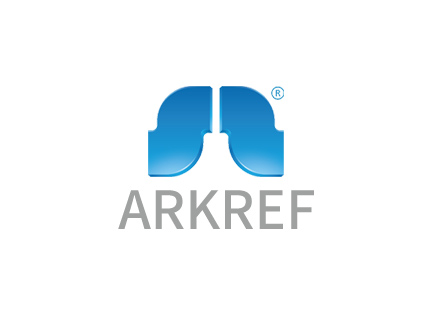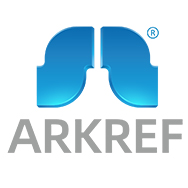Understanding Chillers and Their Cooling Mechanism
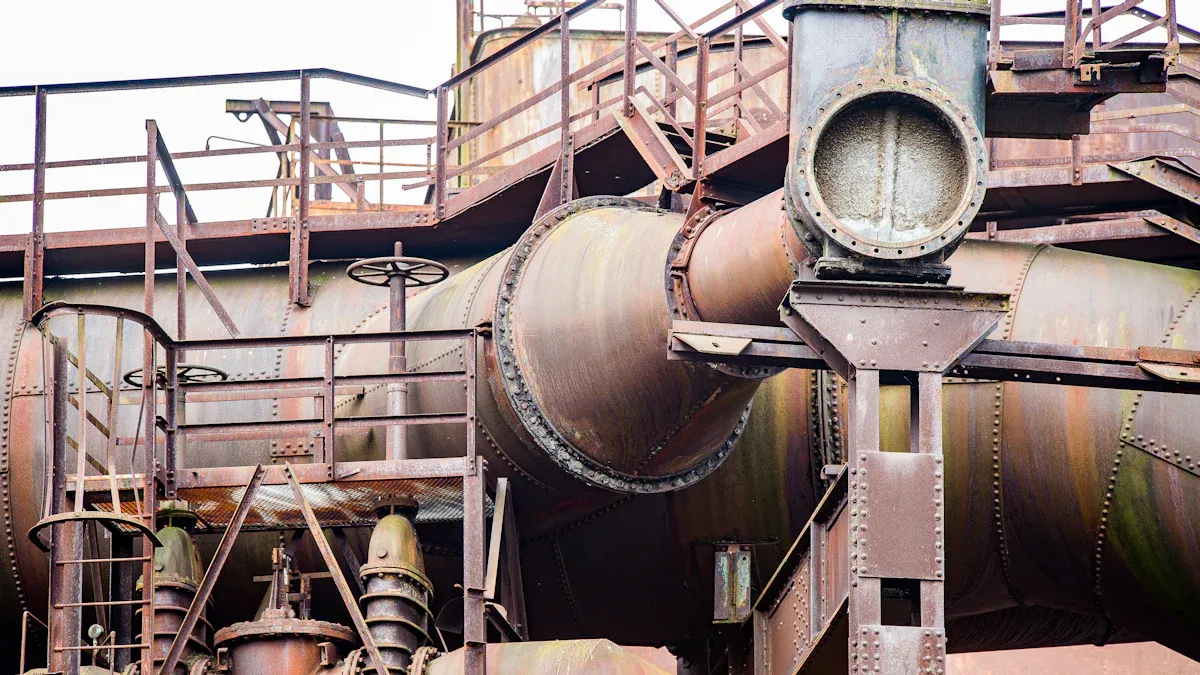
A chiller is a machine that cools down a liquid. This liquid moves through a system to keep things at the right temperature. Chillers are used in many places, like air conditioning and hospitals, where keeping the temperature steady is very important.
The need for chillers has increased a lot around the world.
The cooling market made $177.1 million in 2024.
It might grow to $276.3 million by 2030.
The market could grow 8% each year from 2025 to 2030.
This shows how important chillers are in today’s industries.
Key Takeaways
Chillers make liquids cold by taking away heat. They are important for industries like air conditioning, food storage, and hospitals.
Using energy-saving chillers can cut cooling costs by 10%. This helps save a lot of money over time.
Learning how the cooling process works shows how chillers cool and save energy.
Picking air-cooled or water-cooled chillers depends on your energy use and setup needs.
Taking care of chillers often keeps them working well for longer. It also lowers repair costs and stops delays.
What Is a Chiller?
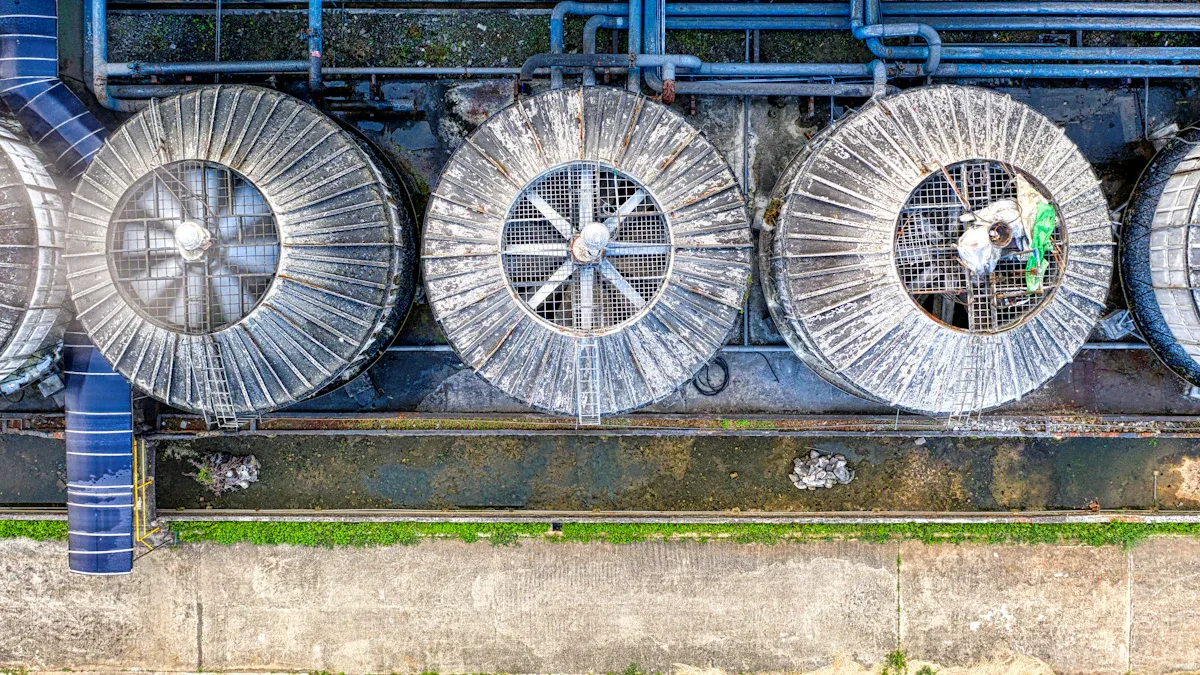
Definition and Function
A chiller is a machine that cools liquids by removing heat. The cooled liquid, often water, flows through systems to keep things at the right temperature. Chillers are used in factories, hospitals, and food plants where exact temperatures are needed.
Chillers help keep systems cool and steady. For example, in making plastic parts, chillers stop molds from overheating or bending. This improves product quality and speeds up production. Companies like LNEYA Thermo Refrigeration Co., Ltd. make chillers that keep temperatures stable for reliable industrial use.
Chillers also save energy. They remove heat efficiently, using less electricity. This makes them a smart and cost-saving choice for cooling buildings or machines. A chiller ensures good performance while saving energy.
Role of Chilled Water in Cooling
Chilled water is key in many cooling systems. It takes heat away from equipment or spaces, keeping temperatures steady. Chilled water is usually cooled below 7°C, making it great for precise cooling needs.
Chilled water systems use less energy than older cooling methods. This lowers costs and helps the environment by avoiding harmful emissions. These systems often use antifreeze, like ethylene glycol, to stop freezing in cold conditions. Strong designs also reduce breakdowns and repair costs.
Food and drink industries depend on chilled water. These systems meet strict rules for cleanliness and temperature control. By keeping steady temperatures, they ensure food stays safe and high-quality.
How Does a Chiller Work?
The Refrigeration Cycle
The refrigeration cycle is how a chiller cools liquids. It moves heat from one place to another using a refrigerant. This process has four main steps: evaporation, compression, condensation, and expansion.
Evaporation: The refrigerant takes heat from the water, turning into gas. This cools the water, making it ready for cooling tasks.
Compression: The compressor raises the refrigerant's pressure and temperature for the next step.
Condensation: The refrigerant gives off heat to the air or water, becoming liquid again.
Expansion: The refrigerant's pressure and temperature drop, so it can absorb heat again.
Different refrigerants work better or worse in this cycle. For example, R290-R717 uses less energy and works more efficiently. On the other hand, R290-R1234yf uses more energy and is less efficient.
Refrigerant Pair | COP Change | Energy Loss Rate (%) | Compressor Energy Use (%) |
|---|---|---|---|
R290-R1234yf | Higher | 21% more than R290-R717 at 50℃ | |
R290-R717 | Lower | Lowest energy loss | Lowest energy use |
R290-R1234ze(E) | Better | 13.4% less than R290-R1234yf | 8% more than R290-R717 |
R290-R600a | Moderate | N/A | 13% more than R290-R717 |
R744-R717 | N/A | N/A | N/A |
Knowing the refrigeration cycle shows how chillers keep things cool efficiently.
Key Components of a Chiller
A chiller has important parts that help it work. Each part has a job in the cooling process:
Compressor: This part pushes the refrigerant, raising its pressure and heat.
Evaporator: It lets the refrigerant take heat from the water, cooling it.
Condenser: This part releases heat into the air or water.
Expansion Valve: It lowers the refrigerant's pressure and heat for reuse.
Chilled Water Circuit: This system moves the cooled water to where it’s needed.
These parts work together to make the chiller run well. For example, the evaporator and condenser move heat, while the compressor powers the process.
Air-Cooled vs. Water-Cooled Chillers
Chillers are either air-cooled or water-cooled, depending on how they remove heat. Each type has its own benefits.
Air-Cooled Chillers: These use fans to release heat into the air. They are simple to set up and need less care. But they use more energy compared to water-cooled chillers.
Water-Cooled Chillers: These use water, often with cooling towers, to remove heat. They save energy and water. For example, water-cooled systems use about 0.36 L/kWh, while air-cooled ones use 1.8 L/kWh. Liquid cooling can also cut energy use and save up to 90% of water.
Choosing between these depends on your needs. If you want to save energy and water, pick water-cooled chillers. If you want easy setup and lower costs, air-cooled chillers are better.
Applications of Chillers
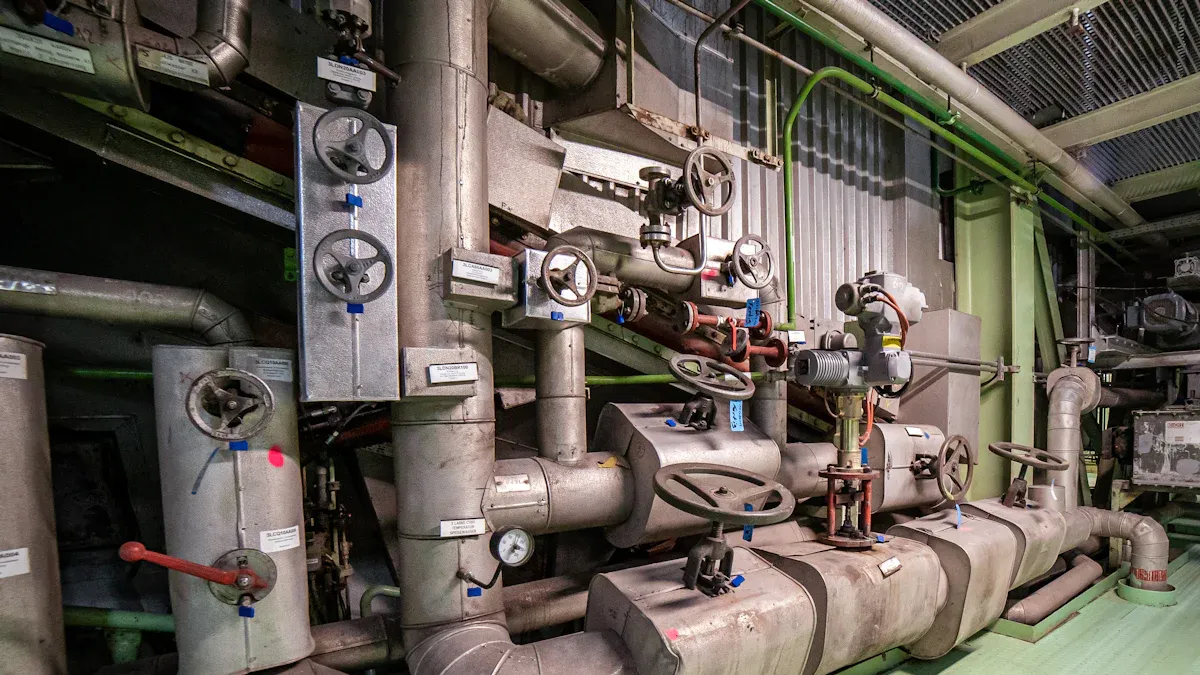
HVAC and Building Cooling
Chillers are important for HVAC systems. They keep indoor spaces cool and comfortable. You can find them in offices, malls, and hotels. Chilled water absorbs heat from the air, cooling the space. This makes chillers useful for small and large areas.
Air-cooled chillers are easy to set up and popular in HVAC. But water-cooled chillers save more energy. They use chilled water to move heat, cutting energy use. This makes them better for big cooling needs.
Industrial and Manufacturing Processes
Factories use chillers to control temperatures during work. They cool machines to stop overheating and improve performance. For example, in plastic making, chilled water cools molds to keep shapes right.
Food and drink industries also need chillers. They keep the right temperature for making and storing food. This helps keep food safe and high-quality. Chemical and medicine industries also use chillers for steady cooling in delicate processes.
Medical and Laboratory Cooling
Hospitals and labs need chillers for cooling equipment. Machines like MRI scanners and lasers make heat while working. Chilled water keeps them at the right temperature.
Labs also use chillers to control temperatures for experiments. They keep samples and chemicals stable. Chillers help ensure accuracy in medical and science work.
Benefits of Chillers
Energy Efficiency in Cooling
Chillers save energy and lower cooling costs. They use smart technology to work efficiently while using less power. High-efficiency chillers, like those with IPLV and COP ratings, perform well in all conditions. Many chillers also have certifications like ENERGY STAR, proving they meet strict energy-saving rules.
Efficiency Type | What It Means |
|---|---|
Full-load Efficiency | Works well at full power |
Part-load Efficiency | Works well at lower power |
Certifications | ENERGY STAR or similar ratings |
Studies show chillers can cut energy costs by 10%. Over three years, this could save $1.5 million, with payback in eight months. These savings make chillers a smart choice for cooling buildings and factories.
Reliability and Durability
Chillers are strong and dependable machines. They keep temperatures steady, even in tough conditions. For example, chilled water systems break down less often, cutting repairs by 67%. This means fewer problems and smoother operations for cooling needs.
Chillers last a long time when cared for properly. They save money over the years by working well without frequent repairs. Whether for a business or factory, chillers are a reliable and smart investment.
Environmental Considerations
Modern chillers are better for the planet. They use low-GWP refrigerants, which cause less harm to the environment than older ones. New refrigerants also protect the ozone layer from damage caused by chemicals like CFCs.
Global Warming Potential (GWP): Low-GWP refrigerants cut greenhouse gases.
Ozone Depletion: Modern refrigerants avoid harmful chemicals like CFCs.
Energy Consumption: Efficient chillers use less power, lowering emissions.
Eco-friendly chillers help the environment while cooling effectively. They support climate goals and reduce harm to the planet. Choosing these chillers is a step toward a greener future.
Chillers are important for cooling systems. They remove heat from liquids to keep temperatures steady. They work using the refrigeration cycle with parts like compressors, evaporators, and condensers. These machines are useful in HVAC, factories, and hospitals.
Here’s a simple overview of their features:
Feature | What It Does |
|---|---|
Cooling Power | Handles 30 kW to 210 kW for different needs. |
Energy Saving | Special fans and exchangers use less energy. |
Versatility | Works with both hard and raised floors. |
Smart Controls | Valves and switches make them reliable. |
Heat Reuse | Uses waste heat to save more energy. |
Strong Build | Aluminum fins make them last longer. |
Free Cooling Ready | Works with free cooling for better energy use. |
Using chillers saves energy, lasts long, and helps the environment. They are a great choice for smart and green cooling.
FAQ
What is the difference between air-cooled and water-cooled chillers?
Air-cooled chillers use fans to cool by releasing heat. They are simple to set up and need less care. Water-cooled chillers use water and cooling towers to remove heat. They save more energy and cost less to run. Pick one based on your cooling needs and budget.
How do I choose the right chiller for my application?
Think about cooling power, energy use, and space available. For big jobs, water-cooled chillers are the best choice. For smaller spaces or lower budgets, air-cooled chillers work well. Always match the chiller to your cooling needs.
How often should I maintain my chiller?
Check your chiller every 3 to 6 months. Clean filters, check refrigerant, and inspect parts like compressors. Regular care keeps it working well and lasting longer.
Are chillers environmentally friendly?
New chillers use safe refrigerants with low Global Warming Potential (GWP). They also use less energy, cutting harmful emissions. Choosing energy-saving chillers helps the planet while keeping things cool.
Can chillers be used for both industrial and residential purposes?
Yes, chillers can cool both factories and homes. Industrial chillers handle big cooling jobs for machines and processes. Smaller chillers work well for homes and buildings. Choose the right size for your cooling needs.
See Also
A Comprehensive Guide To Water Chiller Unit Functions
Maximizing Efficiency Of Chillers And Compressors In ARKREF
Proven Strategies To Enhance Walk-In Chiller Performance
